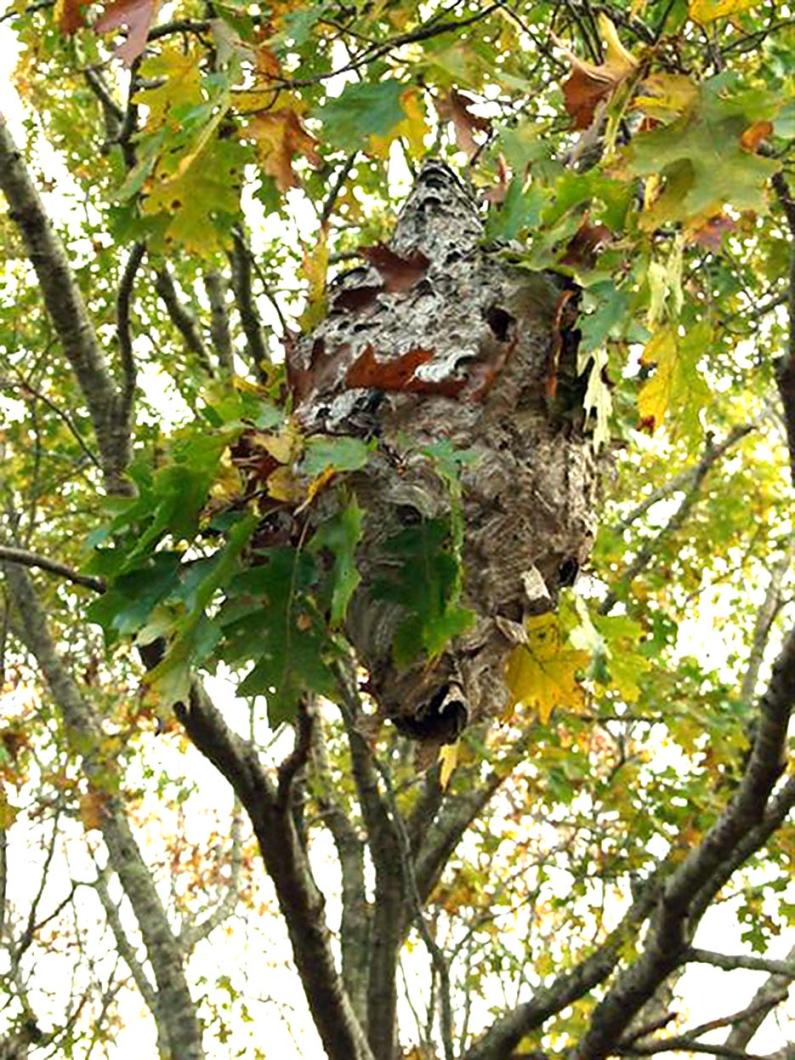The world around us is full of misnomers: hamburgers are not ham, tin foil is actually aluminum, and a shooting star is not a star. Nature has even more: koala bears are not bears, peanuts are not nuts, and a magpie is a bird, not a dessert.
This column is about a hornet that is not a hornet.
Bald-faced hornets are not true hornets. To call them hornets would be, well, a bald-faced lie. They are actually wasps, related to paper wasps and yellow jackets, and are identified by the white pattern on their face, if you cared to get that close.
It’s far safer to use their nests for confirmation of their identity. Their large nests hang in trees, bushes, and on structures. By contrast, the nests of yellow jackets are underground, and paper wasps’ homes (and breeding cells) are open to the elements, not enclosed like the bald-faced hornet’s lair.
I am keeping my eye on a huge, elongated basketball-sized wasp nest — the signature of a bald-faced hornet colony. Along the Old Road, a main trail at Felix Neck Sanctuary, is a large and (hopefully soon-to-be-empty) wasp nest hanging in a tree. While it is a wonder to behold, when it is active, it can be perilous to the unsuspecting walker.
But when it is empty, it is a great teaching tool. After its residents have gone and before it falls or is destroyed by other animals is the best time to take it down. My plan is to wait until the wasp nest, called a carton, is empty. How ironic that at this gift-giving time of the year, I am looking for an empty carton! And empty is what I want, so that I can remove it and be safe from the wrath of the nest’s residents.
Bald-faced hornets are amazing architects and builders. They construct their large, gray papery structure (a natural copy of an Illumination Night lantern) with one or two entry holes on the bottom. It takes them the better part of spring and summer to complete this huge annual project. Using rotted wood, dead stems, leaves and bits of paper and cardboard, these wasps will chew and chew, mix the materials with saliva, and spread it in place while moving backwards to avoid walking on the newly laid materials. Good artisans are known for their attention to detail.
But they won’t get to enjoy the fruits of their labors for very long. The wasps will soon find themselves evicted by the cold weather after long months of industrious building and breeding. As Shakespeare said, “summer’s lease hath all too short a date.” Once winter and the hard frost set in, all the inhabitants of the nest will have to leave. The worker wasps will die, and the queens will overwinter in a hole in a tree or under its bark. The queens emerge in the spring, and won’t be interested in re-colonizing their old home.
New is better to them, as to many homeowners. Instead of fixing up the old place, bald-faced hornets prefer to start again and rebuild their home and empire. Therefore, it will soon be quite safe for me to take down the empty nest for education and closer observation purposes.
A nest, when full of inhabitants, is loaded and dangerous! Almost 1,000 wasps can be found within, and these can sting and sting again and again if they feel threatened. Bald-faced hornets have a barbless stinger, so, unlike bees (which leave the stingers in the victim), the wasps can jab their stingers in and out repeatedly. The wasp guards will also emit pheromones that will signal the others to join in the stinging party.
This weapon is quite an advantage when the insect hunts for food. The wasp’s favorite food is live insects, such as houseflies and small caterpillars. Its capacity to strike again and again led American entomologist B.D. Walsh to write (according to James Clark in Outdoor Indiana) that some people used the insect-devouring propensity of hornets “to a good purpose by suspending one of their nests in the house, thereby eliminating the common housefly. So long as the hornets were not meddled with, they did not meddle with the householders. He continues, however, by saying that he had never seen this take place though he had been told it did work!”
Expert builders, but nomadic, bald-faced hornets are something of a paradox — which seems appropriate for a hornet that is not a hornet. Ferocious fighters who leave delicate works of art behind them: truly an interesting insect to contemplate — from a distance.
Suzan Bellincampi is director of the Felix Neck Wildlife Sanctuary in Edgartown.




Comments
Comment policy »